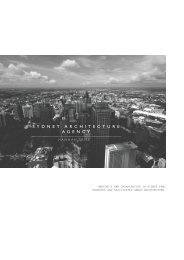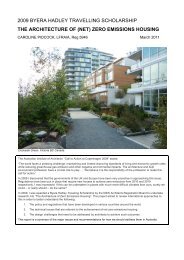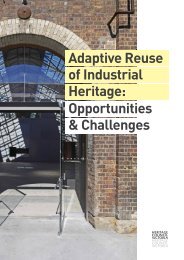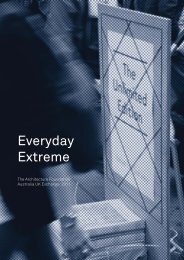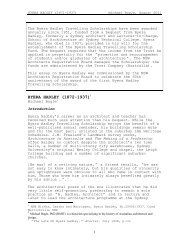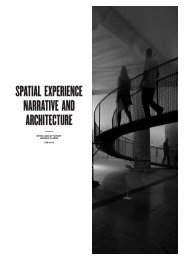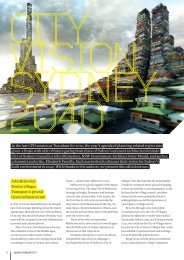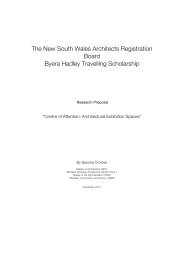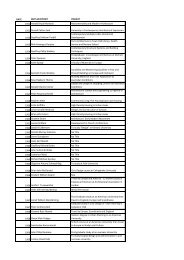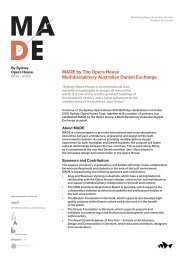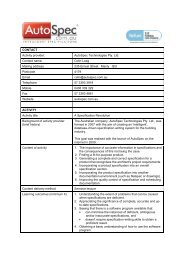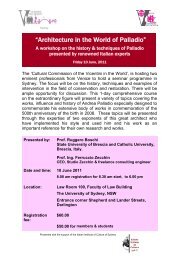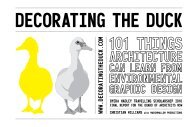4 unités LC - Architecture Insights
4 unités LC - Architecture Insights
4 unités LC - Architecture Insights
Create successful ePaper yourself
Turn your PDF publications into a flip-book with our unique Google optimized e-Paper software.
23 The translation given in Boesiger, W., Girsberger, H., Le Corbusier 1910-<br />
65, Thames and Hudson, London, 1967, p. 26, for the ‘Immeubles-Villas’ is<br />
‘Villas-apartments’, however, ‘Apartment block-Villas’ is actually more<br />
accurate.<br />
24 ‘Immeubles-Villas’ was first exhibited with ‘Une Ville Contemporaine’ at<br />
the Salon d’Automne, 1922, and later with the ‘Plan Voisin’ for Paris in the<br />
Pavillon de l’Esprit Nouveau, 1925.<br />
25 Le Corbusier drew much inspiration for his collective housing schemes<br />
from Charles Fourier’s Phalanstère – a Utopian theory of the early<br />
nineteenth century that described a profit sharing commune based on<br />
monastic collective living (as described in its title, the contraction of<br />
‘phalanx’ and ‘monastère’). He himself refers to Fourier’s theories in Le<br />
Corbusier, The Marseilles Block, trans. Geoffrey Sainsbury, The Harvill Press,<br />
London, 1953. (See also Von Moos, Stanislaus Le Corbusier, Elements of a<br />
Synthesis, The MIT Press, Cambridge, Massachusetts, 2nd Ed., 1980, p. 160;<br />
and Hughes, Robert The Shock of the New – Art and the Century of Change,<br />
Thames and Hudson Ltd., London, 1992, p. 190)<br />
26 Pierre Jeanneret was Le Corbusier’s cousin. He too had studied as an<br />
architect, and in 1922, the two cousins opened a studio together at 35, rue de<br />
Sèvres, Paris. The collaboration lasted until 1940, when Pierre Jeanneret<br />
decided to separate, although they did rejoin and work together again in 1951<br />
for Le Corbusier’s largest project in Chandigarh, India. The anecdote of the<br />
idea for ‘Immeubles-Villas’ is retold in Boesiger, W. + Stonorov, O., Le<br />
Corbusier et Pierre Jeanneret: Œuvre Complète 1910 – 1929, Volume 1,<br />
(text by Le Corbusier), Girsberger, Zurich, 2nd Ed., 1974, pp. 40-41.<br />
27 Boesiger, W., Girsberger, H., Le Corbusier 1910-65, Thames and Hudson,<br />
London, 1967, p. 26, “The Villas apartment-blocks originated in an afterdinner<br />
remembrance of an Italian Charterhouse and sketched on the back of<br />
a restaurant menu.” See also, Jenger, Jean, Le Corbusier: L’<strong>Architecture</strong> pour<br />
Emouvior, Gallimard, Evreux, September 1993, p.77; Von Moos, Stanislaus,<br />
Le Corbusier, Elements of a Synthesis, The MIT Press, Cambridge,<br />
Massachusetts, 2nd Ed., 1980, p. 146; and Curtis, William J. R., Le Corbusier:<br />
Ideas and Forms, Phaidon Press Ltd., London, 2nd Ed., 1992, p. 22.<br />
28 Von Moos, Stanislaus, Le Corbusier, Elements of a Synthesis, The MIT<br />
Press, Cambridge, Massachusetts, 2nd Ed., 1980, p. 146.<br />
51 52<br />
29 Boesiger, W. + Stonorov, O., text by Le Corbusier, Le Corbusier et Pierre<br />
Jeanneret: Œuvre Complète 1910 – 1929, Volume 1, Girsberger, Zurich, 2nd<br />
Ed., 1974, p. 41 (trans. I. Toland).<br />
30 Von Moos, Stanislaus, Le Corbusier, Elements of a Synthesis, The MIT<br />
Press, Cambridge, Massachusetts, 2nd Ed., 1980, p. 143.<br />
31 The influence of Soviet Avant-garde theories on Le Corbusier’s<br />
architecture is discussed in detail in Cohen, Jean-Louis, Le Corbusier and the<br />
Mystique of the USSR: Theories and Projects for Moscow, 1928-1936,<br />
Princeton University Press, New Jersey, 1992. But not only was Le Corbusier<br />
influenced by their theories, for certain design elements they employed also<br />
later appeared in his work, one example in particular being be A. Ol’s twostory<br />
split-level dwelling units interlocking over an ‘internal street’ – the<br />
very same arrangement later employed in the ‘Unité d’habitation’ design.<br />
(See Von Moos, Stanislaus, Le Corbusier, Elements of a Synthesis, The MIT<br />
Press, Cambridge, Massachusetts, 2nd Ed., 1980, p. 143).<br />
32 Von Moos, Stanislaus, Le Corbusier, Elements of a Synthesis, The MIT<br />
Press, Cambridge, Massachusetts, 2nd Ed., 1980, p. 144.<br />
33 Boesiger, W. + Stonorow, O. text by Le Corbusier, Le Corbusier et Pierre<br />
Jeanneret: Œuvre Complète 1910 – 1929, Volume 1 of l’Œuvre Complète,<br />
Girsberger, Zurich, 2nd Ed., 1974, pp. 92-95. See also Vers une architecture<br />
(‘Towards a New <strong>Architecture</strong>’), first published in 1923, where Le Corbusier<br />
equally proposed this integration of industry and architecture proclaiming<br />
that: “Industry on the grand scale must occupy itself with building and<br />
establish the elements of the house on a mass-production basis” (Le<br />
Corbusier, Towards a New <strong>Architecture</strong>, trans. Frederick Etchells, The<br />
Architectural Press, London, 2nd Ed., 1946, p. 12.).<br />
34 The ‘Quartier Moderne Frugès’ /Frugès Modern Quarter (1925-28) in<br />
Pessac, Bordeaux, were designed by Le Corbusier for Henri Frugès, the owner<br />
of a sugar refinery in the region. The project was for a whole new quarter of<br />
factory wokers’ housing utilising principles of Taylorization and industrial<br />
production. This was also the first project in which Le Corbusier used the idea<br />
of ‘polychromy’ (See Boesiger, W. + Stonorow, O., text by Le Corbusier, Le<br />
Corbusier et Pierre Jeanneret: Œuvre Complète 1910 – 1929, Volume 1 of<br />
l’Œuvre Complète, Girsberger, Zurich, 2nd Ed., 1974, pp. 78-86). The<br />
project experienced a great many difficulties both bureaucratic and technical,



